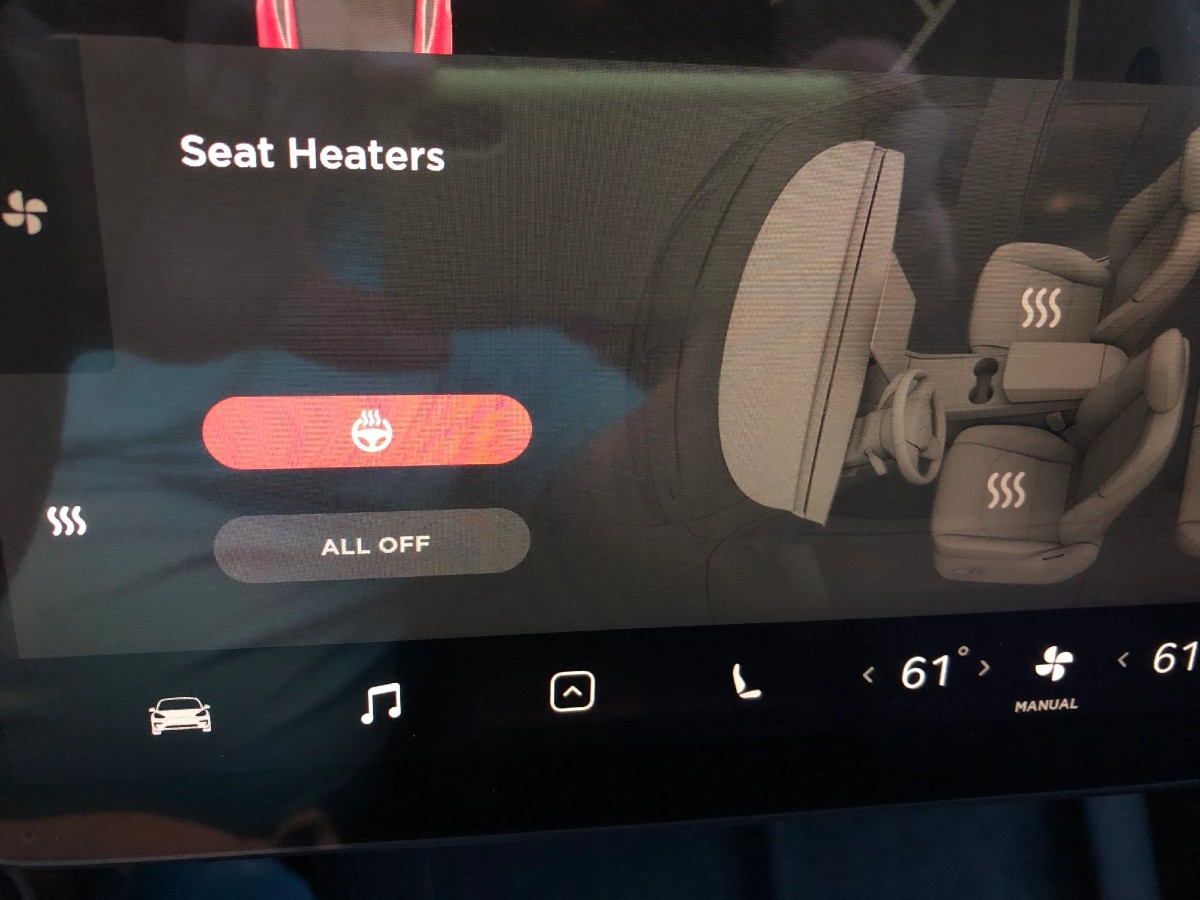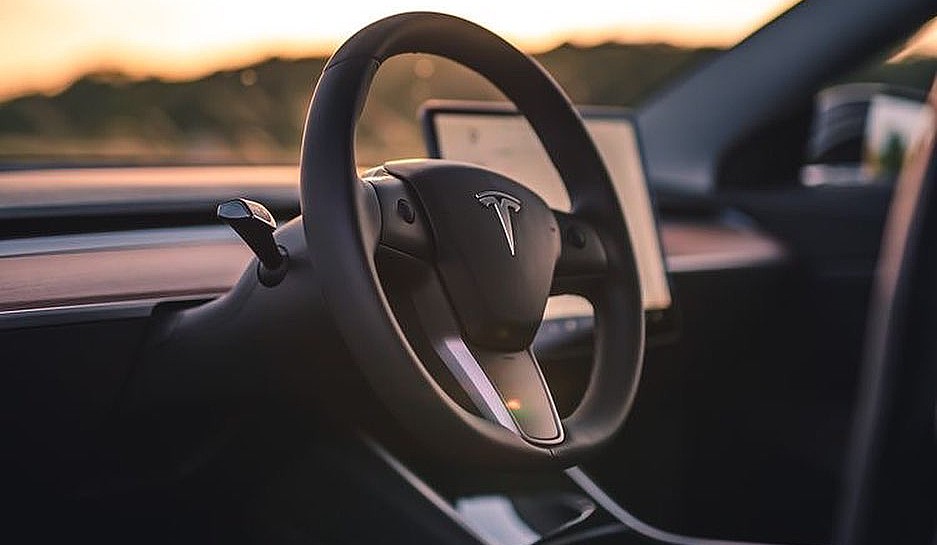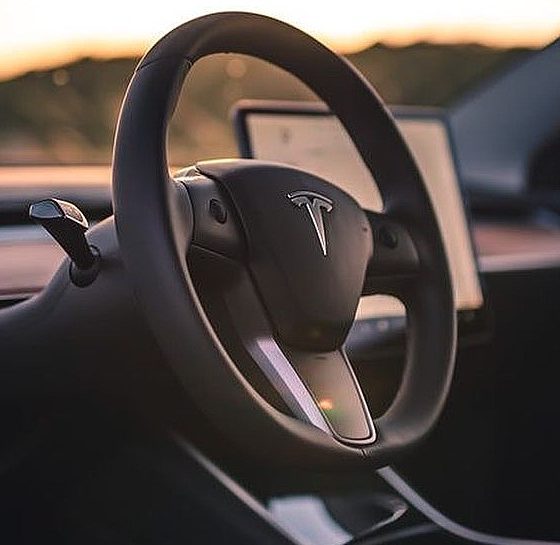Tesla Model 3 customers who are taking delivery of the newest builds of the all-electric sedan are reporting that their vehicle has a heated steering wheel, a feature Tesla included in some of the “refreshed” versions of its mass-market cars.
It has long been speculated whether the Model 3 would be receiving a heated steering wheel. In early December 2020, Tesla hacker green discovered some upcoming features that would be included with the refreshed Model 3, including the powered liftgate, new USB-C ports, and a heated steering wheel. In fact, some owners of newer Model 3 production models felt that their steering wheel had become noticeably thicker compared to previous iterations, setting off speculation within the community that Tesla would be adding the feature within its vehicles. Additionally, owners in other countries, like Switzerland, stated that their cars had been given heated steering wheels.
All the Model3 refresh stuff: new interior (including the top console that nobody noted somehow), heated steering wheel, efficiency package M3 2021 and M3 SR+ 2020Q4 Shanghai (this one is believed to be LiFe batteries?), heated radar, usb-c in glove box, powered liftgate
— green (@greentheonly) October 22, 2020
On New Years Day, Tesla launched a refresh to the Model Y crossover, including some new door panel designs and also adding the heated steering wheel. Speculation regarding U.S. Model 3s also grew when Tesla added the feature to sedans built in China at the company’s Giga Shanghai production facility.
Now, owners taking delivery of new Model 3 builds are showing their vehicles do include the heated steering wheel, a desirable feature for cold weather climates.
Tesla Motors Club member 808BOB took delivery of their Model 3 on Thursday, noticing that his new car did include the heated steering wheel feature. The car was built in February 2021, the original posting says. According to photographs uploaded by the user, the button to activate the heated steering wheel feature is within the “Seat Heaters” menu and can be turned on by pressing the button with a picture of a steering wheel.
Tesla Motors Club | 808BOB
808BOB said in their posting:
“Hi all, just had my M3 delivered on Thursday… Love the car!
BUT, just wanted to confirm that my M3 HAS a heated steering wheel. I’ve been wondering if/when the car would get it…
I was surprised to “find” this option (still finding stuff). Located in the butt warmer section.
RED means it is turned on (it gets pretty warm in the 3/9 locations… you cannot adjust the heat). It was about 67F today, so I didn’t have it on for more than a minute.
Hope this puts an END to all of the speculation? 
Oh, VIN 902xxx
Delivered in the Bay Area.”
The difference between the heated steering wheel and the heated seats is that the steering wheel only has one temperature option, while the seats have three settings. 808BOB stated in their posting that some parts of the steering wheel, especially the 3 o’clock and 9 o’clock locations, seem to be warmer than others.
Some users in the forum stated that new software updates could allow for variable temperatures like the seats. Currently, the vehicle is operating with Software v10.2 (2020.47.101.1).
808BOB stated that they had their car delivered in the Bay Area, so this is likely one of the first Model 3s outfitted with a heated steering wheel. Owners who live nearest to Tesla’s Fremont factory will usually be the first to experience new features because they live so close to the production facility. It is likely that owners outside of the area will soon begin taking delivery of Model 3 units with the heated steering wheel feature included.

Elon Musk
Starlink passes 9 million active customers just weeks after hitting 8 million
The milestone highlights the accelerating growth of Starlink, which has now been adding over 20,000 new users per day.

SpaceX’s Starlink satellite internet service has continued its rapid global expansion, surpassing 9 million active customers just weeks after crossing the 8 million mark.
The milestone highlights the accelerating growth of Starlink, which has now been adding over 20,000 new users per day.
9 million customers
In a post on X, SpaceX stated that Starlink now serves over 9 million active users across 155 countries, territories, and markets. The company reached 8 million customers in early November, meaning it added roughly 1 million subscribers in under seven weeks, or about 21,275 new users on average per day.
“Starlink is connecting more than 9M active customers with high-speed internet across 155 countries, territories, and many other markets,” Starlink wrote in a post on its official X account. SpaceX President Gwynne Shotwell also celebrated the milestone on X. “A huge thank you to all of our customers and congrats to the Starlink team for such an incredible product,” she wrote.
That growth rate reflects both rising demand for broadband in underserved regions and Starlink’s expanding satellite constellation, which now includes more than 9,000 low-Earth-orbit satellites designed to deliver high-speed, low-latency internet worldwide.
Starlink’s momentum
Starlink’s momentum has been building up. SpaceX reported 4.6 million Starlink customers in December 2024, followed by 7 million by August 2025, and 8 million customers in November. Independent data also suggests Starlink usage is rising sharply, with Cloudflare reporting that global web traffic from Starlink users more than doubled in 2025, as noted in an Insider report.
Starlink’s momentum is increasingly tied to SpaceX’s broader financial outlook. Elon Musk has said the satellite network is “by far” the company’s largest revenue driver, and reports suggest SpaceX may be positioning itself for an initial public offering as soon as next year, with valuations estimated as high as $1.5 trillion. Musk has also suggested in the past that Starlink could have its own IPO in the future.
News
NVIDIA Director of Robotics: Tesla FSD v14 is the first AI to pass the “Physical Turing Test”
After testing FSD v14, Fan stated that his experience with FSD felt magical at first, but it soon started to feel like a routine.

NVIDIA Director of Robotics Jim Fan has praised Tesla’s Full Self-Driving (Supervised) v14 as the first AI to pass what he described as a “Physical Turing Test.”
After testing FSD v14, Fan stated that his experience with FSD felt magical at first, but it soon started to feel like a routine. And just like smartphones today, removing it now would “actively hurt.”
Jim Fan’s hands-on FSD v14 impressions
Fan, a leading researcher in embodied AI who is currently solving Physical AI at NVIDIA and spearheading the company’s Project GR00T initiative, noted that he actually was late to the Tesla game. He was, however, one of the first to try out FSD v14.
“I was very late to own a Tesla but among the earliest to try out FSD v14. It’s perhaps the first time I experience an AI that passes the Physical Turing Test: after a long day at work, you press a button, lay back, and couldn’t tell if a neural net or a human drove you home,” Fan wrote in a post on X.
Fan added: “Despite knowing exactly how robot learning works, I still find it magical watching the steering wheel turn by itself. First it feels surreal, next it becomes routine. Then, like the smartphone, taking it away actively hurts. This is how humanity gets rewired and glued to god-like technologies.”
The Physical Turing Test
The original Turing Test was conceived by Alan Turing in 1950, and it was aimed at determining if a machine could exhibit behavior that is equivalent to or indistinguishable from a human. By focusing on text-based conversations, the original Turing Test set a high bar for natural language processing and machine learning.
This test has been passed by today’s large language models. However, the capability to converse in a humanlike manner is a completely different challenge from performing real-world problem-solving or physical interactions. Thus, Fan introduced the Physical Turing Test, which challenges AI systems to demonstrate intelligence through physical actions.
Based on Fan’s comments, Tesla has demonstrated these intelligent physical actions with FSD v14. Elon Musk agreed with the NVIDIA executive, stating in a post on X that with FSD v14, “you can sense the sentience maturing.” Musk also praised Tesla AI, calling it the best “real-world AI” today.
News
Tesla AI team burns the Christmas midnight oil by releasing FSD v14.2.2.1
The update was released just a day after FSD v14.2.2 started rolling out to customers.

Tesla is burning the midnight oil this Christmas, with the Tesla AI team quietly rolling out Full Self-Driving (Supervised) v14.2.2.1 just a day after FSD v14.2.2 started rolling out to customers.
Tesla owner shares insights on FSD v14.2.2.1
Longtime Tesla owner and FSD tester @BLKMDL3 shared some insights following several drives with FSD v14.2.2.1 in rainy Los Angeles conditions with standing water and faded lane lines. He reported zero steering hesitation or stutter, confident lane changes, and maneuvers executed with precision that evoked the performance of Tesla’s driverless Robotaxis in Austin.
Parking performance impressed, with most spots nailed perfectly, including tight, sharp turns, in single attempts without shaky steering. One minor offset happened only due to another vehicle that was parked over the line, which FSD accommodated by a few extra inches. In rain that typically erases road markings, FSD visualized lanes and turn lines better than humans, positioning itself flawlessly when entering new streets as well.
“Took it up a dark, wet, and twisty canyon road up and down the hill tonight and it went very well as to be expected. Stayed centered in the lane, kept speed well and gives a confidence inspiring steering feel where it handles these curvy roads better than the majority of human drivers,” the Tesla owner wrote in a post on X.
Tesla’s FSD v14.2.2 update
Just a day before FSD v14.2.2.1’s release, Tesla rolled out FSD v14.2.2, which was focused on smoother real-world performance, better obstacle awareness, and precise end-of-trip routing. According to the update’s release notes, FSD v14.2.2 upgrades the vision encoder neural network with higher resolution features, enhancing detection of emergency vehicles, road obstacles, and human gestures.
New Arrival Options also allowed users to select preferred drop-off styles, such as Parking Lot, Street, Driveway, Parking Garage, or Curbside, with the navigation pin automatically adjusting to the ideal spot. Other refinements include pulling over for emergency vehicles, real-time vision-based detours for blocked roads, improved gate and debris handling, and Speed Profiles for customized driving styles.










